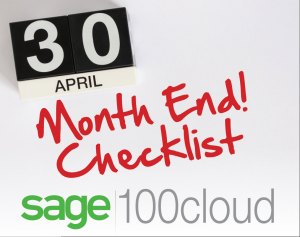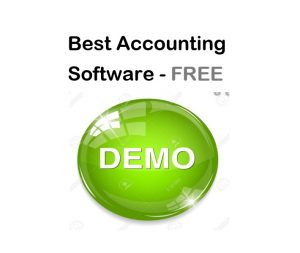Sage 100 Month End Close Checklist

Sage 100 Resource Center
Sage 100 month end close checklist – Each module in Sage 100 has its own close process and its own recommended period end checklist that should be followed during the month end close. This includes a list of Sage 100 reports to run, and step by step instructions to close out and make sure your Sage 100 system stays in balance and on track.
Developed by experienced Sage 100 Consultants providing Sage 100 Period End Support
Request the Sage 100 month end close checklist “at the bottom of the page”
Sage 100 Month End Close Checklist
Each Sage 100 module has a close process. In this article we will outline steps around the core accounting modules used during Sage 100 Month end close. To make it easier a checklist helps confirm all necessary tasks are included and in the right order. Lastly, we have added a few of the frequently asked questions.
Most companies are not ready to close as of the last day of a month. Thankfully in Sage 100 you can record transactions if the current month, future month and prior month all at the same time if necessary. In addition, there are trial balance reports in most modules that can be produced using a cutoff date, so your reports only reflect the dates you choose to include.
Sage 100 Month End Additional Steps
More than likely there are more steps you will need to include for a complete list for your company. These may include Work in Process, Customer and Vendor Deposits, Deferred revenue, retainage, fixed asset depreciation, accrued payroll and more. You can modify the excel based Sage 100 Month end check list and add items you need and remove items you do not need to customize the list for your Sage 100 Month end closing. As time allows, we will post up additional information on these individual topics.
Confirm you have backups of your Sage 100 installation before you begin. Typically, this involves a complete or full backup of your server performed periodically. Backing up your Sage 100 company file folders, all 3rd party add-ons as well as custom reports. If you are hosted in the cloud, ask your provider for a valid usable copy of all mission critical company data files. You can back up by creating a new company and copying all the modules and transactions into the secondary company but a fully server backup is recommended.
Step 1. Monthly reports from Sage 100 and 3rd party add-ons.
These are the minimum monthly recommended Sage 100 reports to be printed to a PDF repository and reviewed to make sure all the subsidiary report totals agree with the balances found on the financial statements. Make sure any reports with sensitive data are placed in a highly secure location.
If you are using more than one system to manage the operations of the business, you may be making journal entries into the general ledger to record the activity. If so, the reports listed below may be produced from Sage 100 or from the 3rd party add on software system.
In addition, there could be reports maintained manually in excel that should be incorporated into your month end checklist. The reports listed below should all be generated using the same period end date regardless of where they are generated.
Financial Statements:
- General Ledger Trail Balance
- Income Statement
- Balance Sheet
- Department level financial statements
Subsidiary reports:
- Bank reconciliation (after the bank reconciliation has been completed)
- Accounts receivable aging detail total = the Balance Sheet Accounts Receivable GL account
- Sales Tax Liability report = total revenue for products and services should agree to the income stated on the profit and loss statement for the month.
- Accounts payable aging detail total = the Balance Sheet Accounts Payable GL account
- Inventory valuation total = the Balance Sheet Inventory account
- Purchase order received Purchase Orders not invoiced report
- Payroll Year to date earnings report look at gross wages. If the fiscal year is calendar = the total gross wages expense account.
Step 2. Reconcile subsidiarity reports to the general ledger balances
The general ledger trail balance is one of the key reports to be used during the reconciliation process. Optionally you can use the Balance Sheet and / or the Profit and loss. It is really easy. You take each report mentioned from the subsidiary, look at the totals and compare them against the period ending balance on the financials to make sure the stated balance amounts agree.
What do I do when the subsidiary reports do not agree to the general ledger trial balance report? Stop and review the transactions for the module to determine the root cause of the out of balance condition. Add correcting transactions or journal entries to correct the out of balance condition.
Do the subsidiary modules agree to the general ledger?
The steps necessary to do a basic review of the health of our accounting software is really simple to follow and are outlined below.
Review all open purchase orders to confirm receipts and accounts payable invoices entry are complete. Review all open sales orders to make sure order shipped have been recorded and customer invoicing is completed.
- Other considerations may be:
- Fixed Asset Depreciation
- Journal Entries
- Accrued Expenses
- Work in Process
- Inventory Adjustments
- Additional Pay compensation
- Automatic prepayments processed
Before you start the month end close process make sure all transactions are posted in each module and updated to the general ledger. Also make sure you have printed and/or saved to PDF your list of month end reports. Once the review is complete and all the subsidiary reports reconcile to your financial statement balances then proceed to the next step which is the actual close.
Step 3. How to I perform the Sage 100 period end close?
Each Sage 100 module had an individual period end process that will move the module period forward into the next month. Note: If you provide financial reports to an external Accountant or CPA at the end of each month to use as the basis of your tax return request a list of adjustments, they have made each month before filing the company tax returns. These changes should be recorded as journal entries into your Sage 100 general ledger, so your Sage 100 financial balances agree to the balances submitted on your tax returns.
Backup of the system and data:
It is strongly recommended that your system and data be backed up nightly and stored in a secure location. It is also recommended that a monthly rotational backup series be kept so that your system may be restored to a prior point in time should the need arise.
Prior to performing your monthly close process, ensure that you have an adequate backup to restore to should an issue arise during the month-end close. Sage MAS 90 and 200 is a tightly integrated system which seldom allows for “individual” file restoration. In most cases, should a situation arise that requires moving back to a “point in time” with the data, all files need to be restored to that “point in time”. If there is a question regarding the restoration of data, it is best to contact your support personnel to determine the best approach to correcting the situation prior to restoring any previous backups of your data.
Order of Closing individual Sage 100 modules:
During the Month-end, quarter end or Year-end closing process all users should be logged out of the Sage 100 system to avoid file conflicts while the program updates the modules totals and clears balances for the new period. You can verify that users are not in the system by accessing Master Console from the “file” menu.
You will see which users are logged in at any given time and be able to see which modules they are working in. If users are logged into the system, you can send them a Broadcast message requesting that they log out for the month-end process. Once you are sure all users are logged out of the system, you can proceed with the close process by following the steps outlined below.
Perform the month-end close in the following order:
- Purchase Order
- Accounts Payable
- Sales Order
- Accounts Receivable
- Inventory
- General Ledger
- Payroll print reports monthly and file state and federal forms
Print reports quarterly and file state and federal forms
Print reports annually and file state and federal forms
Close payroll quarterly and (quarterly/yearly) after final W2’ printing.
General Ledger is always closed last.
All sub-systems should be closed prior to closing the General Ledger. You are not required to close the general ledger and if you choose not to you can post activity to any un-closed period. It is recommended that you only allow transactions within 60 days of the current system date.
Once you have started entering new transactions in any subsidiary module you should not reopen a subsidiary module. Only the general ledger may be reopened once the month has been closed for all modules and any new transactions for a new period have been entered. Be careful when you reopen a period to remember to close the general ledger and bring it back into the current period.
Step 4. How do I know if my financials are correct?
The only way to know is to reconcile the financial statements to the subsidiary information. You may need more on your list than what is mentioned in this post.
Step 5. What if my information is not correct?
You should start by calculating the exact amount you are out of balance. Look at the detail to see if it is a single transaction or perhaps a rounding error or if it may be made up of many transactions that need to be corrected.
Step 6. What information should I give my Accountant or CPA?
Depending on the frequency of financial reviews you may choose to provide copies of some or of all the reports you generated or more than what is mentioned in this post. Normally the accountant or CPA will provide guidance as to which reports they will need. Having your subsidiary ledgers reconcile to the financial statements on a monthly basis will save a lot of steps. When this is not performed you could end up having large periods of time where your system is not in balance. By measuring your financial system balances each month or on a more frequent basis correcting records not properly recorded will be minimal.
Step 7. How do I backup my Sage 100 company data files?
This will need be completed from a windows prompt or using an automated backup software that has been preset to backup all necessary file folders, reports and 3rd party add on applications and data file sets.
Sage 100 Month End Frequently Asked Questions
Question:
What are the potential problems during the close for Sage 100?
Answer:
This process really needs to be completed each month.
Question:
It is not fun to close the monthly books in Sage 100 can’t I just skip this step?
Answer:
Remember that while the close process can seem routine, it’s essential to the business.
Question:
How long does the Sage 100 month end close normally take?
Answer:
Some of the considerations are how large your company data files are, how fast your computer is, how many 3rd party add-ons you have and if you manage your time efficiently and are well organized month end close for Sage 100 may go very quickly.
There is also help in Sage 100 regarding period end close:
- Once you are logged into Sage 100 navigate to help from the task bar
- Select the help topic
- Locate the search window and enter period end checklist
- In the view window displayed will be the individual modules
- and available links for reports will be included
If you need help with your Sage 100 Month End Close or your subsidiary reports do not balance to your financial statements, we can help. Learn more at www.jcscomputer.com or give us a call Toll FREE 800-475-1047. Learn more about Sage 100 Manufacturing
Request month end close checklist - Bottom of the page
Accounting Software Month End Close Checklist
Do More Sage 100 Quarter End Close Today
Be More Sage 100 Year End Close Be Impactful
Info on Sage 100 Operations

- New Users
- Upgrades
- Add-ons

- Certified consultant
- Advanced Reporting
- Implementation

- Remote
- Onsite
- Integrations
 Learn how the right Sage Accounting Software Solution can help take your business to the next level!
Learn how the right Sage Accounting Software Solution can help take your business to the next level!
Give us a call 800-475-1047 Accounting Business Solutions by JCS offers
Sage 100 Support from Certified Sage 100 Consultant